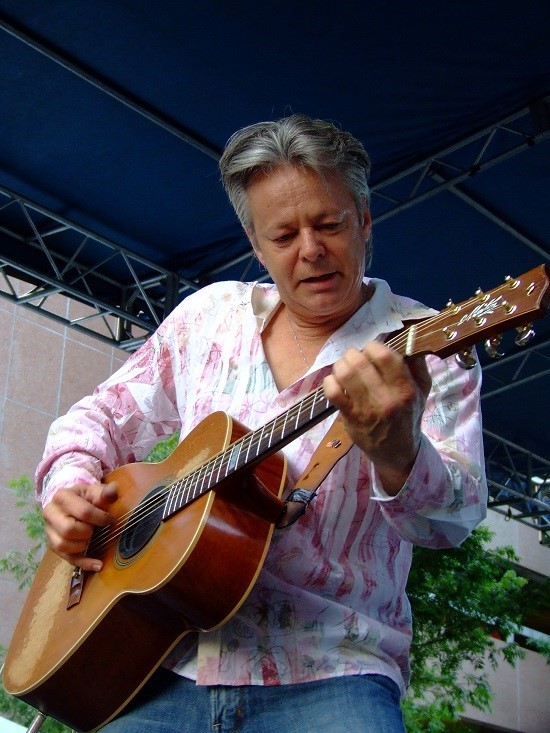When you listen to Tommy Emmanuel play the guitar for the first time, from an
audio source only and not on video, you might wonder whether he has 10 fingers
on each hand, and whether his guitar has 20 strings, instead of the usual six.
Or perhaps whether it is just one musician playing or there are several.
اضافة اعلان
 (Photo: Wikimedia Commons)
(Photo: Wikimedia Commons)
The fact is that Emmanuel, who hails from Australia,
possesses an incredible technique, and is largely considered to be one of the
greatest acoustic guitarists of the last two generations. His technique, often
referred to as fingerpicking, is a hybrid form that taps standard pop-folk
acoustic patterns, and more specifically, on quite elaborate classical methods.
The music he chooses to play is mainstream pop, with a light and nice touch of
jazz and blues here and there.
Musicians who master guitar finger picking are able
to play, at the same time, the melodic line, the chords and the bass line, thus
performing the role of three instruments, or at least of three parts of music
that complement each other to generate a whole. The result, understandably, is
superb music coming out of just one instrument.
It is usually pianists who can perform the trick,
thanks to the fact that they can use up to 10 fingers at one time on a keyboard
that has 88 notes. Guitarists have fewer resources to start with.
Emmanuel is famous in recording studios, music
circles and amongst the industry colleagues, as well as on YouTube where his
videos are watched by tens of millions, mainly for the covers he does of
already known and popular, successful songs.
Although he has recently released a double album of
his original compositions, titled The Best of Tommy Songs, which has 24 pieces
and that is brilliant in all aspects, the covers remain the most sought-after
performances to date.
The control of the dynamics, the bending of the strings to create a blue note effect or a vibrato, all done with subtlety on specific strings of the guitar while he does “something else on the other strings” is simply outstanding.
He has arranged
and performs in an exquisite way evergreens like I Can’t Stop Loving You,
written by Don Gibson and made famous by Ray Charles, Moon River, composed by
Henry Mancini and popularized by Audrey Hepburn, Smile (Charles Chaplin),
Somewhere Over the Rainbow (Harold Arlen), What a Wonderful World, written by
Bob Thiele and George David Weiss, and made famous by Louis Armstrong, or John
Lennon’s Imagine, to mention a few.
Emmanuel’s playing technique is extraordinary; he
also maintains an equally extraordinary level of expression. The control of the
dynamics, the bending of the strings to create a blue note effect or a vibrato,
all done with subtlety on specific strings of the guitar while he does
“something else on the other strings” is simply outstanding. The man impresses
and seduces with the sound of his guitar, which is one of the sweetest you can
hear.
Emmanuel is
particularly skilled at playing harmonics on his guitar. This consists of
lightly touching a string in specific, precise places, and not pressing it
against the fingerboard, so that only the harmonic parts of the note, the
highest pitched, resonate. This technique creates the effect of a music box.
Whereas most performers can play only a few simple
notes this way, the Australian virtuoso can play fast and full, complex lines
of harmonics – a unique treat for trained or connoisseur ears who can
appreciate it.
On the “that’s too bad” side is the guitarist’s
tendency to cross the red line and to add fast bluesy-jazzy improvised lines to
an otherwise straightforward pop song that does not really lend itself to such
treatment. It does not occur frequently, one must admit.
Among the great guitarists generally considered
masters of the finger picking style are the late Chet Atkins, Marcel Dadi and
Glen Campbell, the three pioneers of the genre, and more recently, rock icon
Mark Knopfler, along with Walter Rodrigues Jr. and the young Gabriella Quevedo.
Countless performers around the world, including amateur guitarists and music
students, have approached or learnt the fine art of finger picking thanks to a
special music sheet scoring method called tablatures. Very few, however, can
take it to the level Emmanuel and the above-mentioned musicians do.
The writer is a computer engineer and a classically
trained pianist and guitarist. He has been regularly writing IT articles,
reviewing music albums, and covering concerts for more than 30 years.
Read more Opinion and Analysis
Jordan News



